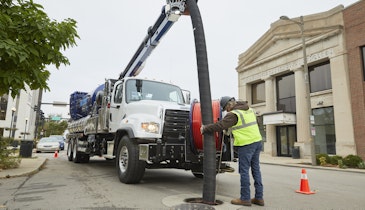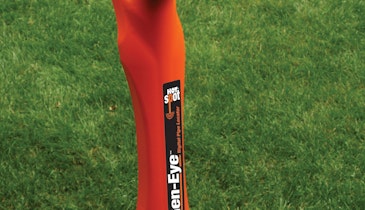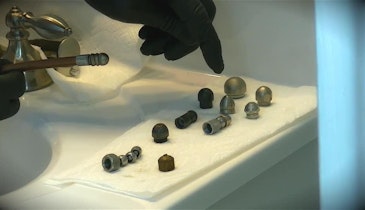Interested in Municipal/Industrial?
Get Municipal/Industrial articles, news and videos right in your inbox! Sign up now.
Municipal/Industrial + Get AlertsA new complex of condominiums on a hill in Daly City, Calif., would increase sewage flows and overwhelm the 800-foot-long, 8-inch vitreous clay trunk line.
Tom Piccolotti, city water and wastewater manager, asked John Rafferty, field director for TRIC Tools Inc., to burst and upsize the sewer by four inches. During the walk around, Rafferty saw utility-locating marks everywhere and the hill’s severe grade.
“It made no sense to burst the entire line with its numerous service connections and adjacent utilities,” he says. “Only 160 feet at the flat foot of the hill was a candidate because the sewer crossed beneath a live 8-inch high-pressure water main, the sidewalk, and a busy roundabout.” Shoring, cribbing, and an undetected service lateral turned the job into an adventure, but it came off successfully.
Short of perfect
The city removed the upstream and downstream manholes for the entry and pull pits and installed a trench box in the 9-foot-deep upper hole. They then excavated and shored three separate holes to expose the 4-inch service laterals.
To fuse the 12-inch SDR-17 HDPE pipe, Michael Lien and Bob Zamaroni blocked off one lane of a residential street across from the entrance pit. After fusing the 180-foot-long pipe, the men chained it to a nearby chain link fence to keep it out of harm’s way overnight.
The next morning, Rafferty and Robert Ding, TRIC’s mechanical engineer, found the manhole pit too short to position the ram behind the trench box. Furthermore, the type of box and its position to the sewer were not ideal. The legs were level with the pipe instead of the majority of the box, making cribbing more difficult.
“Pulling from behind provides stability and enables us to use the interior of the box as the extraction frame for the bursting head,” says Rafferty. “To provide more extraction length inside the box, we extended the cribbing with 8- by 10-inch buttress beams, which moved the resistance plate back 18 inches.”
Rafferty used a 20-gpm/4,000-psi high-flow pump to power TRIC’s HFHD-100 ram with two 5-inch cylinders. The ram, rated at 100 tons, was inches from the temporary sewer bypass.
At the entry pit, Piccolotti directed a backhoe operator as he used the bucket to bend the HDPE pipe enough so that the 8-inch Unified Force bursting head entered at the proper angle to pass under the cast-iron water main. “The water and HDPE pipes were almost kissing,” he says.
The bursting head, with a 4-inch-tall dorsal blade 12 inches long, was attached to a 12-inch skirt expander screwed to the new pipe. The expander created the annular space for the larger pipe. A cable adapter connected the head to the 1 1/8-inch compact swage cable.
Rock and roll
As the pull began, alternating slack and tension on the cable rocked the ram. The motion caused the cribbing to fail, flipping the 1,200-pound apparatus, breaking the annulus on the 15-inch-diameter pulling wheel that supports the ram, and deforming its steel nose.
While city welders reattached the annulus, Rafferty and Ding removed and sculpted the ram’s nose with a grinder, enabling the cable to pass through again. They then rebuilt the cribbing with crossbeam blocking. “We sacrificed 18 inches of extraction length – we needed four or more feet – but this structure was stable,” says Rafferty. The pull resumed 90 minutes later, requiring 30 to 40 tons of force. Once the new pipe entered the pulling pit, a city worker cut the bursting head off with a chain saw.
Normally, laterals are saddle fused using a jig, which requires 32 inches of radial space from the pipe. Because of a storm sewer directly above the work area, Rafferty and Ding didn’t have that room, so they used the jig’s heating iron, a clean 2x4, and a crowbar. The men took turns tying in the laterals.
After cleaning and roughing up the surface of the new pipe, Rafferty and Ding heated it and the 4-inch stub. The two pieces were held together by jamming the crowbar into the ground and leveraging it against the 2x4 and stub.
From using the jig with its pressure gauge, they knew what to look for and applied the correct force to the crowbar for four to five minutes. They then bored the inlet hole using a 3 3/4-inch core drill. The other man stood topside lowering and retrieving the tools. Robert Donati, sewer crew foreman, connected the services.
Surprise, surprise
After the last saddle connection, city workers noted soapy water and some sewage running upstream into the pulling pit. Piccolotti assumed the source was an apartment building where residents were doing laundry. When the city poured green dye down the laundry room drain, it arrived in the pit. Workers located the apartment’s tie-in point, and the next morning potholed and shored a 3- by 2-foot-wide shaft 6 feet down to the lateral.
“The camera inspection failed to reveal this lateral and we burst right through it,” says Rafferty. “The service was about eight feet downstream from the pulling pit, but the flow went both ways by following the avenue of least resistance – the disturbed soil from the burst.”
Ding squeezed around the shoring struts and into the narrow shaft to plug the lateral with a short pig. Near the end of the saddle fusion process, the pig blew out, drenching Ding in laundry water. “The city told apartment residents not to wash clothes, but they didn’t listen,” says Rafferty. “We worried that the fusion might cool too fast, but it was fine.”
The city’s hydroexcavator vacuumed the water from the pit, enabling Donati to connect the service. When the new condominiums are occupied, the owners will enjoy trouble-free, uninterrupted sewer service.





